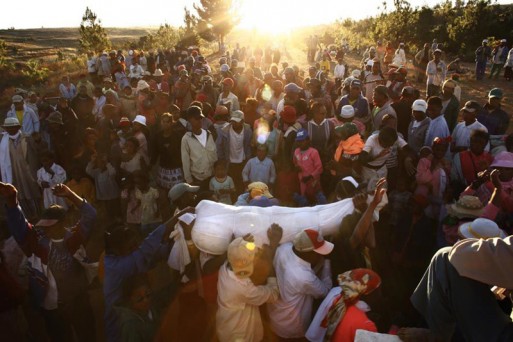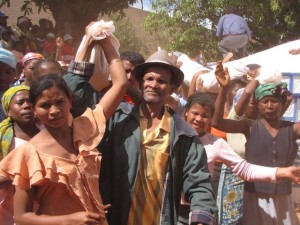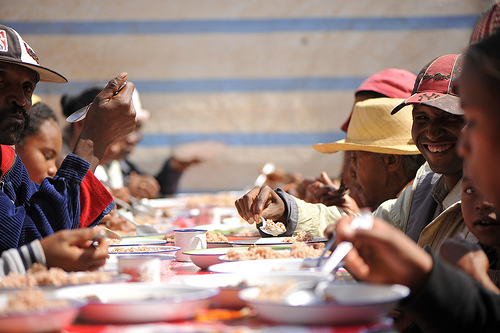Not long ago, SevenPonds explored a fascinating part of Madagascar’s Malagasy culture: the tradition of second burial or “Famadihana.” The tradition is rooted in the belief that the body of the deceased needs time to decompose to properly pass into the next world. To aid this process, a Malagasy family will unearth the body from its burial site after seven years to commence “the turning over of the bones,” and bury it once more after an elaborate ceremony.
Famadihana is a costly and elaborate tradition, and often a family will have to wait longer than seven years to preform the ritual. But when the time comes, the body of the deceased is wrapped in a fresh white shroud and often buried in a new (and ideally upgraded) crypt. And before the family says goodbye to the deceased yet again, they gather to raise the newly enshrouded body high, and celebrate the life of the deceased loved one with the aid of song and dance.
Because Famadihana can be an expensive ceremony, often extended families will preform the turning of the bones for several bodies simultaneously. The result is a large ceremony bustling with the energy of countless family and friends. Famadihana is well known for being such a community-driven, and hence, deeply personal ritual.
But it also creates the space for a pretty great party.
And why not commemorate the occasion with an air of festivity? For the Malagasy people, the ceremony is an opportunity to remember the life of a loved one with joy in lieu of a stagnating, somber attitude. Grief is a necessary part of the end-of-life process and should be embraced, and it’s likely the air of Famadihana ceremony is bittersweet. But there is still a pervading air of merriment and remembrance that sets the ceremony apart from much graver, and more dispiriting burial ceremonies typical of Western cultures.
The ceremony has become so internationally renowned that even popular tourist travel sites like Lonely Planet have highlighted the ceremony as a must-see. “Far from gloomy,” the site says, “[Famadihana] is really a great party, more like a wedding than a funeral” that has “much dancing to accordion music and drinking of gasoline-like rum.” One visitor to Madagascar says that “people kept offering me shots of rum, bumming cigarettes, and inviting me to dance.” Nearby, he says that “the immediate relatives of the dead huddled over the remains of their beloved, tenderly stroking their shrouds, singing songs, laughing and crying at the same time, and pouring rum on the decomposing bones in thanks for all the blessings.”
The entire community comes together through Famadihana to celebrate the life of the deceased, with family members and friends traveling across continents to attend the event. Elders impart knowledge to the children at the ceremony while food is prepared and shared alongside meaningful and lively conversations about the deceased in a way that de-stigmatizes the role death can play in our everyday life.
And why not commemorate the occasion with an air of festivity? For the Malagasy people, the ceremony is an opportunity to remember the life of a loved one with joy in lieu of a stagnating, somber attitude.
SevenPonds connected with Jacques Randrianary, a filmmaker native of Madagascar whose documentary “Famadihana (Second Burial: Surviving Guilt and Grief) is soon to be released. “[I’ve] created a documentary on the ceremony [and] brought some originality [to it] in terms of the family story,” he tells us. The documentary is sure to show Famadihana in an insightful, original light, as it explores the many complexities associated with making the ceremony a reality. Check out the trailer below:
Famadihana: Surviving Guilt and Grief (Trailer) from Jacques Randrianary on Vimeo.
Related Articles:
- The Little Known Ritual of Endocannibalism
- Taking the Time to Say Goodbye: Vietnamese Funeral Customs
- Buddhism and the Eastern Middle Ground

 Famadihana: The Malagasy Perspective on Death and Burial
Famadihana: The Malagasy Perspective on Death and Burial





 “As Tears Go By” by Marianne Faithfull
“As Tears Go By” by Marianne Faithfull
 “The Sea” by John Banville
“The Sea” by John Banville
 Funeral Favors Offer Visitors a Tangible Memento
Funeral Favors Offer Visitors a Tangible Memento















